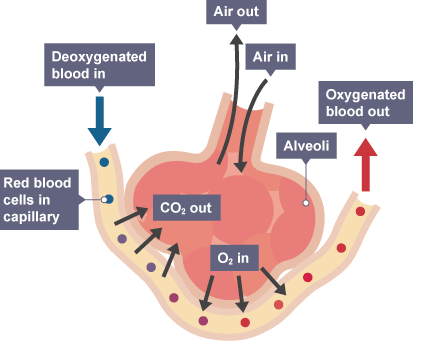Hikers Reaching the Summit of Mt. Everest
Only one in four climbers who attempt to climb Everest survey and summit. Currently there is over two hundred bodies on the mountain. The biggest killer on Everest is not the cold but rather the lack of oxygen in the atmosphere. At the summit oxygen levels are a third of what they are at sea level. After ascending 26,000 feet climbers enter the death zone, an area where the oxygen levels are not high enough to support human life. Low levels of oxygen in the body is called hypoxia.
The body will try to compensate for the lack of oxygen by creating more red blood cells which aid the transportation of oxygen to different tissues. Oxygen fills the lungs because of changes in pressure and diffuses into surrounding capillaries from small pouches called alveoli because of a concentration gradient. Red blood cells contain hemoglobin which are proteins that attract oxygen. A hemoglobin has four polypeptide chains and a haem group attached to each chain. Every haem group can bind to one oxygen molecule. When hemoglobin is oxygen deficient the RBC releases s-nitrosis which dilates blood vessels.
Oxygen Diffusion in the Lungs
This dilation can cause increased pressure in the most oxygen hungry parts of your body like the lungs and brain. This increased pressure can lead to HAPE and or HACE (high altitude pulmonary edema and high altitude cerebral edema). Pressure from excess blood flow causes fluid to leak out of the vessels and build up in the lungs and heart. If descent is not immediate the effects are fatal within hours.
HACE diagram
HAPE diagram
Low oxygen levels without the conditions HAPE or HACE can cause fatal outcomes. Lack of oxygen in the body can cause fatigue because oxygen is a necessary reactant in cellular respiration. Cellular respiration is the biochemical process which organisms convert stored energy into chemical energy mainly ATP. Hikers who stop to rest can be frozen to death. Hypothermia an extremely detrimental drop in body temperature (below 95 degrees Fahrenheit) can kill even an experienced hiker on Everest. The average temperature of the summit during climbing season or July is -2 degrees Fahrenheit. It can take days for the person to die, and in the end it may be because of different reasons like lack of food/water. The temperature will make you immobile.
Climbers often experience something called summit fever, a mental state that drives someone to disregard all safety to reach the top. Too often it costs the life of the climber or someone their climbing with. There is no real science behind why someone might enter this state but lack of oxygen to the brain can help fuel their dilusions.




No comments:
Post a Comment